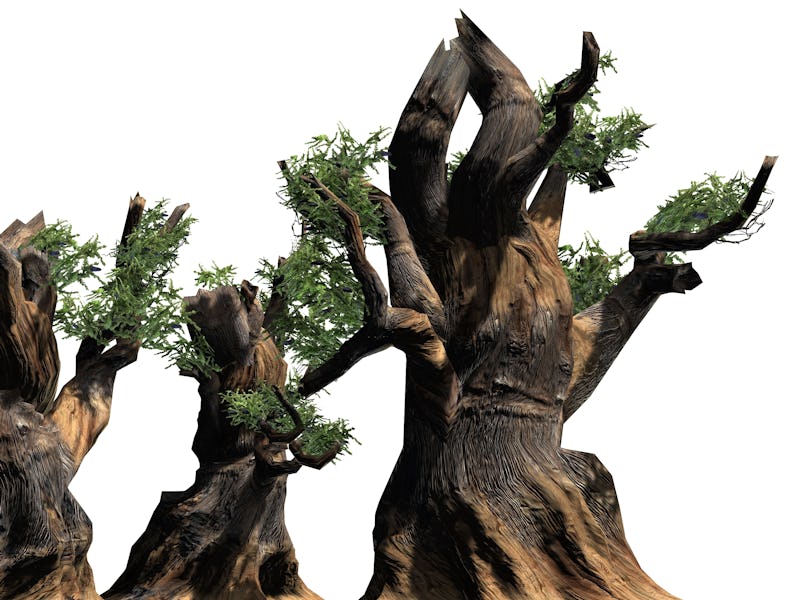Longevity study reveals why ancient trees can stave off death
New research "can help us better understand the concept of time in biology."

For at least 2,500 years — possibly much longer — the tree Jomon Sugi, a Japanese cypress, has lived on the legendary Yakushima Island in Japan.
In Sicily, the Hundred-Horse Chestnut is an estimated 2,000 to 4,000 years old.
Meanwhile, the world’s oldest tree is a bristlecone pine named Methuselah in eastern California. For the tree's safety, its exact location is a secret. It is 4,851 years old.
Through a special combination of biological defenses, these elder florae are able to escape some of the most taxing effects of aging. New research illuminates why.
To deal with environmental stress like extreme temperatures, drought, and nutrient deficiency, the planet's long-living trees have two tricks: they grow slowly, and they can regenerate vascular tissue — the complex conductive material that allows water and nutrients to travel through the plant.
A review study published Monday in the journal Trends in Plant Science outlines these methods for survival. Sergi Munné-Bosch, a professor at the University of Barcelona, wrote the paper.
In the paper, Munné-Bosch explains that trees' secret for living thousands of years comes down to the meristem, a tissue made of undifferentiated cells that can divide and become any tissue or organ that a plant needs to live.
Trees produce new meristem in a modular growth cycle, revolving around the tree's trunk. As new tissue is added, old tissue is allowed to die. Millennial trees — those living thousands of years — do this to the extreme, Munné-Bosch says: The trunk of a super old tree is around 99 percent dead tissue while living tissue is protected by tree bark. New shoots grow from the mostly dead trunk.
With this method of growth, millennial trees are remarkably adept at preventing the typical "wear and tear" that aging brings. They do such a good job that it's almost impossible to detect the aging process in trees in nature. Paradoxically, the planet's oldest trees appear virtually ageless.
Ancient bristlecone pine tree in California's White Mountains.
"Indeed, the design of the plant body as a mosaic or modular structure, allows the organism to virtually escape from senescence," or aging, Munné-Bosch writes.
Still, he notes, this process is not to be confused with immortality.
Immortality vs. longevity — Despite being able to regenerate vascular tissue, trees can't live forever unless they produce new trees, Munné-Bosch says.
While a 2019 research article focusing on Ginko trees suggested that the ages-old trees may be immune from aging. Munné-Bosch argues otherwise.
"There has been a long debate on the topic for decades," Munné-Bosch tells Inverse. "That we cannot gauge senescence in several long-lived plants in nature does not mean that long-lived trees are immortal. Immortality can only be attained through the germ line or by producing clones."
Reviewing past claims of immortality in trees, and how some trees accomplish strikingly long lives, "can help us better understand the concept of time in biology," Munné-Bosch says.
"There has been a long debate on the topic for decades."
Time itself, for instance, is a threat to these mega-old trees — since their age heightens their chances of dying from non-aging causes. It's not deteriorating from old age that they have to worry about, it's encountering something that will kill them as the years add on.
Climate benefits — As previous research has shown, long-living trees can benefit the planet when it comes to climate change.
A study published in April found that trees that grow slowly, live long lives, and are particularly large, make up most of the biomass in the forest. That means they play a disproportionately large role in storing the carbon dioxide that's warming the Earth.
Researchers say these trees, dubbed "long-lived pioneers,” make a case for why targeted forest protections are key to curbing climate change and improving the forecast for the planet's future.
Summary: Separating out the different effects of aging on long-lived trees remains challenging. Herein current approaches used to explore senescence in millennial trees are highlighted. Molecular and biochemical analyses of the vascular cambium provide novel insight into the extent to which millennial trees can withstand the wear and tear of aging.
This article was originally published on